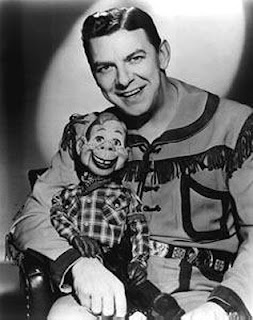"Howdy Doody" Celebrates 60 Years

On December 27, 1947 one of TV's first success stories debuted, Howdy Doody, which began as Puppet Playhouse, seen three times a week on NBC. Through 1948 and 1949, with its title change to Howdy Doody, and now airing five times a week, every child with a television set knew the answer to "Say kids! What time is it?!"
Host "Buffalo Bob" Smith sang the theme song "It's Howdy Doody Time" which was sung to the melody of "Ta-ra-ra Boom dee-ay." Howdy began as a long faced cowboy puppet but got a make-over in June 1948 to the now-familiar-looking freckled-face one. In addition to Bob and Howdy, there was a cast of characters now well known to every baby boomer— there was Phineas T. Bluster, and Chief Featherman (who uttered "Cowabunga!"-- one of writer Eddie Kean's many inventions) and Princess Summerfall Winterspring (played by Judy Tyler) and then there was "Clarabell," the clown. "Clarabell," with seltzer bottle in hand, spoke no words and would communicate by blowing a horn.
Seats for the Peanut Gallery (the show's all-child studio audience) became a hot-ticket item as the show's popularity skyrocketed. During the height of the show, in September of 1954, Bob Smith suffered a heart attack and to cover, the children were told that Buffalo Bob was off on a secret mission, until his return in 1955.
On September 24, 1960 the show ended with Clarabell's famous silence-breaking moment, "Goodbye, kids."
The Archive interviewed many of the talented creators behind the series, including Bob Smith and first Clarabell, Bob Keeshan. Producer/director E. Roger Muir's interview has now also been posted, click on the link below.
E. Roger Muir's three hour interview can be found at this link.
Interview description:
Muir detailed his early television directing experiences, on such shows as James Beard's cooking show I Love to Eat and Perry Como's The Chesterfield Supper Club. He later became the producer of The Howdy Doody Show, which he produced throughout the program’s run. He also spoke about the creation of “Gumby,” which debuted on the program. He later went on to head children’s programming at the network.
